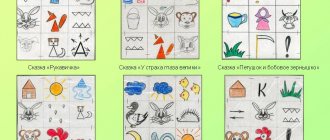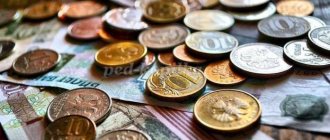Formation of financial literacy of preschool children
Nadezhda Borovinskaya
Formation of financial literacy of preschool children
The federal state educational standard for preschool education sets the task of forming a general culture of children’s personality, which includes the economic culture of the personality of a preschooler , and is characterized by the presence of primary ideas about economic categories, intellectual and moral qualities (frugality, ingenuity, hard work, the ability to plan things, condemnation of greed and wastefulness ).
Today everyone understands that the fate of the state depends on the economic, legal, political and moral literacy of the younger generation . Economics has always been an integral part of human life. In the changing conditions of modern society, continuous economic education must begin precisely from preschool age , when children acquire primary experience in elementary economic relations. A preschooler will not master this area on his own, but together with teachers and parents, traveling through this new amazing and exciting world, he acquires the knowledge available to him and understands what place economics occupies in the reality around him.
The novelty of my experience lies in the use of a block system that promotes the formation of financial literacy in preschoolers . Children should know that they must live within their means and spend less than they earn. It is clear that money cannot buy happiness, but it is useful for children to know that a sufficient amount of financial resources opens up great opportunities for them that can give joy. The earlier children learn about the role of money in private, family and social life, the earlier healthy financial habits can be formed .
The choice of topic is explained by the need to improve the quality of the educational process in kindergarten. There is an urgent need to educate preschoolers as a fully developed personality, harmoniously combining intellectual and moral qualities.
The essence of economic education lies not in organizing special education in economics, but in enriching various types of children's activities with economic content. Saturating the lives of preschoolers with basic economic information contributes to the development of the prerequisites for the formation of real economic thinking, which will make this process more conscious. In my opinion, the formation of the foundations of financial literacy should be based on role-playing games, such as “Shop”
,
“Cafe”
,
“Supermarket”
,
“Fair”
, etc. This will not be something out of the context
of preschool education , and at the same time, it will help the child to socialize into the economy.
In preschool pedagogy, the problem of economic education and training was considered as an integral part of labor education. This is evidenced by the works of such researchers as R. S. Bure, L. S. Dzinters, I. V. Zhitko, L. M. Kazaryan, L. V. Krainova, L. Ya. Musatova, V. G. Nechaeva and others Some researchers consider this problem as a synthesis of labor, moral and ideological-political education, therefore it is not considered an independent direction.
Analysis of program and methodological manuals for preschool institutions , such as Kurak E. A. “Economic education of preschool children ”
, Smolentseva A. A. “Introducing
a preschooler to the basics of economics with the help of fairy tales”, Shorygina T. A. “Conversations about economics”
shows that a purposeful system of work in this direction has not yet developed with
preschool .
As prerequisites for economic culture, the authors identified only knowledge accessible to children in the field of economics and the quality of activity, which gradually becomes personal. The purpose of pedagogical experience is not only to broaden the economic horizons of a preschooler , but also to give an idea of such economic qualities as hard work, frugality, thriftiness, and thrift. Help the preschooler realize that economic benefits can only be achieved through hard work, and work should be understood not only as a means of achieving these benefits themselves, but also as creation, as a creative process that brings joy and satisfaction.
To develop the foundations of financial literacy and systematization of knowledge in children of senior preschool age, I set myself the following tasks:
1. Create conditions for the formation of basic economic knowledge in children.
2. Teach to understand and appreciate the surrounding objective world (as a result of people’s labor, to see the beauty of human creation and treat it with respect.
3. Develop the emotional sphere of children, the ability to understand their emotional state, regulate their own behavior, form positive self-esteem, and the ability to recognize the feelings of other people.
4. Develop in children the skills and habits of speech etiquette, cultural behavior in everyday life (behave correctly in real life situations with reasonable needs).
5. Form the right attitude towards money as a necessity of life.
her work on developing financial literacy in preschool children into several stages:
Preparatory: problem detection, selection of diagnostic material and identification of the level of acquired knowledge .
Organizational: determining the content and scope of work; study and analysis of literature, Internet resources; selection of software and methodological support and demonstration material; creation of a subject-development environment; development of a long-term work plan, questioning of parents.
Main: testing experience in developing financial literacy in a kindergarten.
Final: analysis of the effectiveness of resolving contradictions, monitoring.
The success of developing financial literacy in children largely depends on what methods and techniques the teacher uses to convey certain content to children, to develop their knowledge , skills, abilities. The activity is focused on the joint activities of participants in the educational process in the following combination: teacher-pupil - parents.
Educational activities with pupils include the following methods and techniques: direct educational activities, role-playing, didactic, board games; intellectual games and entertainment are of particular interest, where children solve cognitive, practical, and gaming problems. Logical problems and joke problems enliven the way of understanding complex economic phenomena. They combine elements of challenge and entertainment, cause tension in the mind and bring joy, develop fantasy, imagination and logic of reasoning. Solving logical problems increases a child’s interest in economic knowledge and teaches them to see life and the beauty of the world of things and nature behind names and terms. Excursions and conversations are held to meet people of different professions. Conversations are held to determine how much the children have mastered the material. Mastery of economic content is carried out in the process of reading fiction. Reading poems, fairy tales, memorizing proverbs and sayings cultivates the best moral qualities in children. Many proverbs and sayings in a generalized form contain ideas of economic feasibility, moral values, and attitudes towards work. Since the senior preschool age I have been introducing the pedagogical technology of the case method.
The created favorable, comfortable conditions allow each child to find his own path into the “economy”
through play, mathematics, drawing, etc., provide
formation and cognitive needs, promote mental and personal development.
The leading pedagogical idea of the experiment is to determine ways to develop financial literacy in preschoolers through the introduction of a block system of interaction between children, their parents and teachers in kindergarten.
my work with preschoolers on developing financial literacy into eight economic blocks. (Appendix No. 1)
Block 1: Economics. This is, first of all, a solution to two key questions: where do funds come from (not necessarily money, and how to use them. To teach to identify economic characteristics in the surrounding world. To develop the ability to identify economic content from a fairy tale.
Block 2: Need. Children receive knowledge and ideas that a person, as a living being, like animals and plants, needs water, air, heat, light, food, clothing, shelter, i.e., needs without which a person cannot exist. However, children should know that in addition to these, there are other, no less important, so-called social needs: the need for safety, love, friendship, protection, communication, etc.
Block 3: Labor and professions. Children learn that people work to feed themselves and their families, to make provisions for the future, and to benefit others. In the process of labor, people create and produce various objects and products of labor. Production is impossible without the means of production, with the help of which the process of producing labor products is carried out. In order to make something, you need to know the manufacturing method, which is called technology.
Block 4: Goods, commodity exchange. The exchange of goods and services is a way to satisfy economic needs. To sell and buy in a playful way , children study supply and demand and accept “orders”
for goods and services. Involving children in the production of advertising, tracking with them the effectiveness of advertising. There is a development of ideas: about supply and demand and their influence on the price; on setting prices; about the exchange of goods and services.
Block 5: Benefit and loss. To form a positive attitude towards the work of people who know how to work well, earn money honestly, recognize as authoritative the qualities of the owner, frugality, rationality, economy, generosity, nobility, honesty, responsiveness.
Block 6: Money and family budget. Children become familiar with the concept of “money”
as a general equivalent, and also with the fact that they are also a product, but unusual, since its quantity always turns out to be equivalent to another product that can be exchanged for them.
In addition, money is a means of payment for purchases and sales. It is necessary to bring children to the fact that any product has its price. Some goods are expensive, others cost less (cheaper)
.
Block 7: Advertising. Advertising is certain information that is packaged in an original form . In addition to information, advertising carries a certain emotional mood. This is why children love advertising so much and play with it. Give maximum information with a minimum of words , highlight the main, characteristic features of the advertised object, advantageously emphasize its difference from others and prove its advantages.
Block 8: Business and capital. Continue to introduce children to the concepts of the economic category “Business”
,
“Capital”
,
“Purchase and sale”
, as a type of business, highlighting the components of capital. Foster a negative attitude towards greed and self-interest; business qualities of the individual, a sense of admiration for ingenuity, kindness.
Based on the listed topics, we can conclude that work on developing financial literacy should be carried out according to the developed block system and carried out in stages.
The work of economic education of a preschooler is impossible without the participation of parents. At the first stage of work on this topic, an anonymous survey was offered to parents, in which 20 respondents took part; they answered 9 questions that related to the topic of developing financial literacy in preschoolers . An analysis of the questionnaires showed that 96% of parents believe that it is necessary to tell their children about money, but 76% do not agree to introduce them to economics, while at the same time 88% had a positive attitude towards their child’s desire to have a piggy bank. The survey showed that the majority of parents consider it too early to introduce economic education into the pedagogical process, and expressed the opinion that this topic is complex and not interesting for children. Phased and targeted informing of parents made it possible to increase the level of knowledge of adults about the use of economic concepts in a kindergarten, and to continue to implement the practical experience gained by children in the family.
At all stages, the child’s support at home and in the family is required. The accumulated experience makes it possible to determine some areas of joint activity between teachers and parents in the economic education of preschool children .
These include:
1. survey of parents on the topic of developing financial literacy of preschoolers ;
2. informing parents about the tasks and content of economic education of children in kindergarten and at home (Appendix No. 2)
;
3. participation of parents in the work on economic education of children in kindergarten (economic fairs, educational quests, competitions)
;
4. creation of an enriched developmental environment at home.
Experience shows that only the joint work of a preschool institution and a family gives good results and contributes to a more serious and responsible attitude of adults towards the economic education of children.
Monitoring the development of financial literacy of students is carried out on the basis of selected economic categories and indicators for them (Appendix No. 3)
.
As a result of targeted work throughout the year in this area, the qualitative indicators of the level of development . The number of children with a high level of development increased by 21%, and children with a low level of development decreased by 9%. The presented results indicate positive dynamics in the development of economic thinking in preschool children .
Based on the above, we can conclude: the block system of work has a positive effect on the formation of financial literacy , and therefore the foundations of economic culture in preschool children . This work allows you to activate children’s cognitive activity and improve their communication skills. Preschool children develop an interest in people of different professions, they have become more careful not only with toys, but also with objects in their environment, they have a creative approach to solving game problems, and relationships in the children's team have improved.
Bibliography:
1. Antonova Yu. Discuss and play: creative tasks for children on financial literacy . – M.: VITA-PRESS, 2022. – 56 p.: ill.
2. Vinogradova A. M. Education of moral feelings in older preschoolers / Ed . A. M. Vinogradova. M. - 1989.-159 p.
3. Menshikova, O. I., Popova, T. L. Economics for children, big and small - M.: TC Sfera, 1994.-157 p.
4. Sasova I. A. Economic education of children in the family. M. - 1989.-137 p.
5. Smolentseva A. A. Introduction to the world of economics or how we play economics: Textbook: St. Petersburg, 2001.-130 p.
6. Smolentseva A. A. Introducing a preschooler to the basics of economics with the help of fairy tales: A practical guide. -M.:ARKTI, 2006.-88 p.
7. Smolentseva, A. A. On the problem of economic education of older preschoolers / A. A. Smolentseva, M. A Moiseeva // Preschool education . -1998-No.5.-s. 12-16
8. Uleva E. Where does the money come from?: Encyclopedia for kids in fairy tales. Rostov n/d: Phoenix, 2022. – 45 p.
9. Shatova A. D. Is economic education necessary and why for a preschooler / A. D. Shatova // Preschool education . -1989.-No.7.-s. 21-23.
10. Shatova A. D. Economic education of preschool children . Educational and methodological manual. M.: Pedagogical Society of Russia, 2005.-256 p.
11. Shorygina T. A. Conversations about economics: Methodological recommendations. - M.: TC Sfera, 2022. - 96 p.
Introducing preschoolers to the world of finance
Psychologists advise starting a conversation about finances when a child becomes interested in it. Usually this is the age of 5-6 years. Children's questions must be answered at a level accessible to the child.
- Teach your child about the basic needs of the family
The son or daughter must come to the understanding that not all desires can be satisfied and that the money earned by the parents is spent on certain needs.
- When planning a store visit, make a shopping list with your child
If he doesn't know how to write yet, let him draw pictures. In the store, stick to this list and ask your child to help you choose a product. This will distract the baby from persistent requests to buy another toy or sweet.
- Teach your child to choose the right product and pay attention to quality and expiration date
- Introduce your child to the professions of all family members, tell them about specific responsibilities
If possible, take a tour of Mom or Dad's work. Explain that every work is important and useful.
- Do not leave things or toys damaged by your child without attention.
Explain that you can’t buy a new car because the money has already been spent on the one he broke. Offer to find a way out of this situation. For example, fix a damaged toy together.
Since preschoolers’ main activity is play, this means that the basics of financial literacy will be better learned in a playful way.
Teachers suggest using the following financial and economic games:
"Shop"
The child and adult alternately play the roles of seller and buyer. Both real objects and their images can be used as goods.
With children under 5 years old, it is better to use candy wrappers, pieces of paper or stickers as “payment” for goods. Older children can already “pay” for goods with real money: coins or bills that they receive from their parents.
"Bank"
The game introduces the child to the structure of the banking system and basic banking operations. Before this, it is recommended to take your son or daughter on an excursion to a real bank.
The child and the adult alternately take on the roles of a cashier and a visitor who needs to take out a loan, open a deposit or deposit money into an account.
Such role-playing games help children develop the necessary algorithm of behavior and master the culture of relationships between people in financial institutions
"Professions"
The child gets acquainted with various professions through games and activities in kindergarten.
Parents, in turn, can tell him about the work of each family member and play an entertaining game that reinforces the acquired knowledge.
The baby is offered cards with various objects and tools. His task is to determine which profession person needs this item and why.
"Getting to Know Money"
In this game, an adult introduces a child to bills and coins and teaches them to count correctly.
You can instruct your child to put small coins in a special jar, and at the end of the week count how much has accumulated.
Junior school age (7–11 years old)
Teaching children financial literacy at this stage helps in communicating with adults and classmates. By primary school, a child should be able to shop and understand what change and change are or how paying by card works. This is important, at a minimum, for purchasing lunches in the canteen. Give him a piggy bank so he can put money gifts in it.
Make it clear that every thing has a price
In elementary school, introduce your child to shopping in large stores and the meaning of a receipt. Ask him to pay at the checkout. Try not to indulge your child’s momentary desires while shopping. Tell them that things have a price and why each one has a different price. Then make a list of what you want and determine what you need to do to buy it.
For example: “If you perform at the Math Olympiad, we can buy you this thing.” The main thing is not to reward your child for studying well or cleaning his room. So, he can start blackmailing. Encourage only extra efforts - things that are not part of his responsibilities.
Read books on financial literacy for children
Organize useful reading together. For example, Sergei Fedin has a book “Financial Literacy” in two parts. This is a textbook with questions and tasks about both the family budget and the history of economic processes. Another option is “A Dog Called MoneY” by Bodo Schäfer. The main character is a Labrador who teaches the girl Kira to understand money. You can read Igor Lipsitsa - “Amazing Adventures in the Country of Economics.”
Download financial literacy apps for kids
With the support of the Ministry of Finance of the Russian Federation, the game “Finnknowledge” was developed for children in grades 1–4. It is available on Android or IOS. There you can solve tests, quests, crosswords and riddles on the topic of budgets, banks, currency and business. The advantage of the application is that parents can register as mentors and create their own tasks.
You can also take lessons on financial literacy at Umnasia. This is an online platform where there is a whole interactive course on financial literacy for primary and secondary schoolchildren. The course program has 5 steps, and the tasks are done in a playful way. They will improve money handling skills, develop the child’s independence, increase interest in learning, and introduce banking products and the main laws of money.
Play Monopoly
The legendary board game Monopoly (aka Manager, Businessman, or Empire) is a great option for teaching budgeting and planning. "Monopoly" develops economic thinking, determination and attentiveness.





